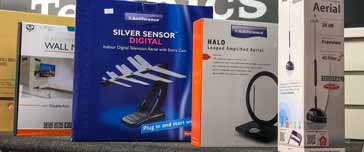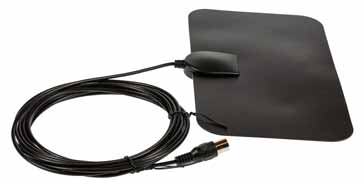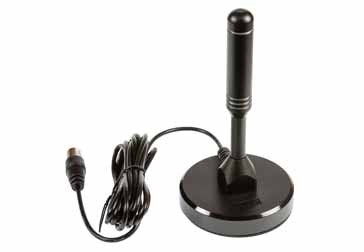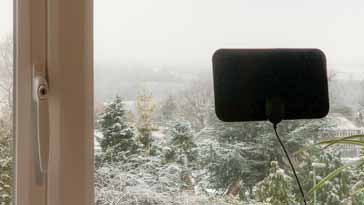Indoor TV Antennas & How to Set Them Up
Knowing about indoor TV antennas and understanding the top tips for how to set them up is crucial when wanting to use one.
Home » Antennas & Propagation » this page
TV antennas guides include:
Types of TV antenna
Buying a TV antenna
TV antenna direction alignment & pointing
TV transmitter finder app
TV antenna alignment meter
Buying TV antenna amplifier / booster
Indoor TV antenna & set-up
Satellite TV dish installation
How to wire a TV antenna socket
Why doesn't a TV antenna work any more
General antenna installation guides
Antenna installation guide
Attic installation
Antenna height
It is common knowledge that an external TV antenna will be better than an internal one, but for some situations an indoor TV antenna is the only option.
Understanding a little of how indoor antennas work and the issues that can arise will help when setting them up to get the best performance.

Indoor TV antennas come in a variety of shapes and formats, but the same basic issues and set up precautions apply in virtually all cases.
Not only can indoor antennas be very useful for use in homes, flats, apartments, etc where no external antenna is available, but they are also very useful for motorhomes and the like where normal external antennas are not feasible.
Indoor TV antennas
Indoor TV antennas are a form of antenna designed for internal use and as a result they are designed to fit inside a modern room and are not intended for external use as they are not designed to withstand the rigours of the weather.
Also they are smaller than their counterparts intended for external use and they are designed to be used within a room, often being flat, or using a single vertical element, and some use a circular format.
There are actually four main types of indoor TV antenna and this gives a choice of the type that suits the room decor and the performance needed.
Log periodic: These log periodic antennas are very similar in overal concept to the ones for external use. They may have individual elements in the antenna, or the elements may be etched onto a printed circuit board. These antennas are directional and they also cover a wide bandwidth making one antenna suitable for the whole UHF band, etc.
The internal log periodic antennas will have more gain than some other internal antenna types, but they will not have the same level of gain as one intended for external use. This is because of the size constraints.
They will also need to be orientated correctly to gain the best signal.
Monopole TV antennas: The monopole style of antenna consists of a single, normally quite thick vertical element. Most of them have a round base which is often magnetic for easy fixing to a metallic surface. The pole may need to be placed vertically or horizontally according to the polarisation of the incoming signal.
These monopole TV antennas have an all round directivity at right angle tot he axis of the pole, i.e. they receive equally in all directions that are at right angles to the pole itself, but they receive less off the top and the bottom of the pole.
Loop TV antennas: Loop TV antennas have, as the name indicates of a circular shape. They tend to have a flat base which enables them to sit on a flat surface without difficulty.
Flat panel antennas: Flat panel antennas can often be fitted into a modern room with little difficulty. They can be mounted on a stand, a wall or even a window, and possibly look less 'electrical' than other types.

A flat indoor TV antenna
These antennas often come with adhesive pads so that they can easily be mounted on a flat surfaceFlat panel TV antenna are effectively configured by folding the various elements needed into a flat slimline case.
Some of these indoor TV antennas are passive, having only the basic conductive elements of the antenna itself. However, others are what are termed active antennas. These have an amplifier built into the basic antenna to amplify the signal.
These active antennas need to be connected to a power source - often a mains or line power supply. They may often have a gain control because if the signal is too strong then it can give rise to interference and overloading which will degrade the performance of the television.
Indoor vs outdoor TV antennas
Although indoor TV antennas follow exactly the same laws as external ones, they are designed to meet the requirements of indoor operation. Typically this means that they are smaller or designed to be flatter than external ones.
External TV antennas are typically long and would not fit comfortably into a typical indoor room. They also would not look very attractive in a typical furnished room.

These antennas often have a magnetic base for easy mounting on steel metallic surfaces - they can be used vertically or horizontally
However the size of the external means that they will provide good performance giving gain and directivity.
Indoor TV antennas are also designed to fit aesthetically into a modern living room. There are various different styles and these can vary somewhat in their performance, so choices between performance and aesthetics may need to be made.
The indoor environment is not so good for antennas. The walls can mask or attenuate the signals, especially of the walls become wet when it rains, etc. Also objects within the internal environment can mask the signals which can cause issues.
Another issue when using internal TV antennas is that reflections become more of a problem. The TV signals can bounce off walls, and metal objects causing reflected signals. These can interfere constructively and destructively with the main signal making the overall signal stronger or weaker. It is even found that someone walking around the room can change the signal levels.

These antennas often come with adhesive pads so that they can easily be mounted on a flat surface
Obviously an internal or indoor TV antenna is not as good as an external one, but when this is the only option, then it is necessary to use one.
Points to consider when buying an indoor TV antenna
There is a good wide choice of indoor TV antennas and when considering to buy one there are a few pointers and useful tips that may help with the choice.
Unfortunately it is not possible to guarantee that an indoor antenna will work well enough with a TV, but if there is a good strong signal int he vicinity, then it should ot be a problem. However, if the signal is weak, an indoor antenna may struggle to pick up a sufficiently good signal.
There are several considerations:
Type of TV antenna: One of the first decisions to make about the indoor TV antenna is the type that is wanted. Aesthetics will play a part, but so will aspects such as the performance. A balance between the two is needed.
Antenna size: One key aspect of the indoor TV antenna will be its size. Often the larger antennas will give better result, so a balance may need to be made between size and signal reception.
Active or passive: It is worth deciding whether a passive or an active antenna is needed. The passive ones have the advantage that they are likely to be cheaper, and the will not need an additional power supply socket. However the active ones will give more gain and if there is a question over whether there will be sufficient signal, an active one might be better.
Cable length: The length of the cable may be an important factor. As the positioning of the antenna will be dependent not only on where it looks good, but where the signal is acceptable, a long lead may be needed. Fortunately antenna lead extensions can be bought if needed, but it helps to know the length of the cable in case an extension might need to be bought.
Fitting / mounting: The fixtures fort he antenna might also be important. Some TV antennas come with an optional stand, while others may have magnetic of even adhesive pads or mountings.
Impedance: One specification that is often mentioned is the impedance. This is the antenna impedance and for maximum signal transfer the television and the antenna should have the same impedance. Virtually all televisions and TV antennas have a 75Ω impedance. It is very unlikely that any other impedance will be stated for a TV antenna.
Maximum range: A specification for the maximum range is often quoted with many indoor antennas. This is very misleading because the reception is dependent upon many more factors than just the antenna. Often this specification should be disregarded.
Frequency coverage: Normally these antenna will cover the UHF band for televisions, but check it will cover the bands needed for your location. Some also say they will cover some of the sound broadcasting bands. This may or may not be a requirement.
Connector: Make sure that the indoor TV antenna has the same type of connector as the television itself. Belling Lee and F type connectors are the most common. If the TV and the antenna have different connector types, it is possible get adapters for most types. If this is the case, then consider buying one at the same time as buying the antenna.
How to set up an indoor TV antenna
An indoor TV antenna is not complicated to set up, although it may not be so easy to get the optimum position for reception.
Nevertheless, these antennas can work well if they are in an reasonably high signal area and the antenna is well placed.
In order to gain the best performance there are several top tips that can be used to ensure the antenna is set up as well as it can be:
Initial set-up: Ensure the TV antenna is plugged into the TV and it is set to receive signals - if this cannot be done then a TV signal strength meter can be used to locate the best signal strength and then the TV can be tuned to receive the stations. This is a bit of a chicken and egg situation as the TV will need to be able to receive signals
Select location for the TV antenna: The best locations for the TV antenna are often higher up as this keeps them away from as many objects as possible. Near a window can also be a good location as this is often free from other objects.
Keep antenna away from metal objects: Metal objects will screen and reflect the TV signal. For the best reception it is best to keep the indoor TV antenna away from metal objects. Also remember that many windows have a metal frame (even plastic double glazed windows have a metal framework), so if the antenna is mounted on a window, keep it in the centre of the glass pane for best reception.
Remember reflections occur in the room: One of the annoying points with having an indoor TV antenna is that it will be subject to reflections, and even people moving in the room can cause these reflections to vary and the TV signal to be changed as people move around. Keeping the antenna higher up, or near a window can help reduce these problems.
Select polarisation: Television signals are normally polarised, either horizontal or vertical. The TV receiving antenna needs to be the same polarisation as the signals.
The polarisation of the antenna is the same as the elements in the antenna: monopole antennas are normally vertically polarised, although they can be mounted horizontally as well; log periodic ones normally stand as horizontally polarised ones, and again they can be used on their side, and for the flat panel ones, check the leaflet that comes with the antenna.
When setting up the indoor TV antenna it is worth remembering that are very many variables affecting the antenna's performance that it is very difficult to predict how well any particular antenna will work. Although the designs of the antenna do play a part in determining the performance, the location and aspects including the path to the transmitter, whither there are trees outside, the walls of the dwelling, objects int he dwelling, and a host of other factors.
As such it is difficult to predict whether one antenna or another will work, and whether any antenna might work. The only real way is to try it and see whether it works and optimise the location within the room as well as possible.
Although an indoor TV antenna will not be as good as an external one, they can be the only convenient solution for TV reception in some circumstances. When an indoor antenna is needed, careful experimentation and sensible positioning can enable them to give a good account of themselves and provide good TV reception.
Indoor antennas have the advantage that many are low cost and they can easily be set up without the need for professional TV antenna installers, cutting the costs of te installation when compared to an external one. This can make them a very attractive proposition in some instances.
 Written by Ian Poole .
Written by Ian Poole .
Experienced electronics engineer and author.
More Antenna & Propagation Topics:
EM waves
Radio propagation
Ionospheric propagation
Ground wave
Meteor scatter
Tropospheric propagation
Antenna basics
Cubical quad
Dipole
Discone
Ferrite rod
Log periodic antenna
Parabolic reflector antenna
Phased array antennas
Vertical antennas
Yagi
Antenna grounding
Installation guidelines
TV antennas
Coax cable
Waveguide
VSWR
Antenna baluns
MIMO
Return to Antennas & Propagation menu . . .


